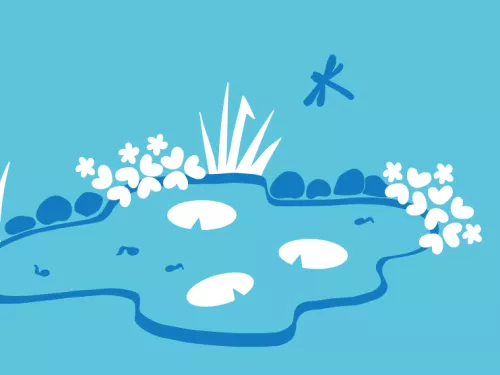
How to create a mini pond
Even a small pond can be home to an interesting range of wildlife, including damsel and dragonflies, frogs and newts.

Caring for a pet is a rewarding experience that doesn't have to cost the earth.
There are so many small changes we can make in our own lives to be more environmentally friendly, including when we are caring for our pets. Just changing the products we use and small choices we make can have a huge impact on wildlife and the environment as a whole.
Changing the small, everyday choices we make can have a huge impact on wildlife and the environment.
Walking to a nearby park rather than driving to the dog park, or attaching a bell to your cat’s collar to reduce the risk of them catching wildlife can make a world of difference over the years.
There are also impacts that dogs can have on the environment that you may not be aware of, like contributing to river pollution. But the good news is that there are simple things you can do to ensure that you and your dog taking care of the environment!
So, whether you’re seasoned in the art of caring for furry companions, or you’re taking the first steps to becoming a pet owner, here are some tips to help you minimise your pets’ environmental pawprint.
When exercising your dog, follow any local guidance or on-site signage to ensure that your pet isn't disturbing wildlife, or stressing the grazing animals that create and maintain habitat.
When visiting rivers, keep your dog out of the water if they have recently been treated with a topical flea treatment. These are essentially pesticides which can leach into the water and cause harm to aquatic wildlife, like dragonfly, beetle and mayfly larvae.
If the site you're visiting allows dogs to swim, encourage your dog to stay in the water rather than climb in and out repeatedly, especially if there are bankside plants at risk of being trampled.
Bare soil erodes easily, releasing sediment into the river which is harmful to the insects and fish that live there. You might not know that severe erosion that even lead to bank collapse! Use areas of hard standing if there are any - some sites even have specially-installed 'dog dips' providing access points to the water which don't contribute to erosion.
The British Veterinary Association also have advice on responsible use of parasiticides on their website.
If your pet eats a plant-based diet, the main area you should focus on is packaging. If you can buy food loose, carrying it using your own reusable containers, this is the best way to avoid packaging. Otherwise, try to find food with recyclable packaging, or buy in bulk as long as you can be sure that the food will be used before its expiration date.
Meat is resource-intensive to produce, can be a source of pollution, and carries a significant environmental footprint. For cats and dogs on meat-based diets, pick food with lower impact meats like chicken and try to stay away from beef, whose carbon footprint far exceeds that of any other meat. While they might seem like a good idea, human-grade meats used in high end pet foods put additional pressure on our food production systems: try looking for pet food made from by-products of the meat industry like bonemeal and organ meat, or with high plant-based content. If you’re after fish-based food, make sure it’s certified sustainable.
With plenty of inspiration and recipes online, there’s never been a better time to have a go at making your own pet treats! Making your own and storing them in a reusable, resealable container can be a great way of skipping the wasteful packaging that comes along with most commercially available pet treats, and leaving out environmentally damaging ingredients like unsustainable palm oil.
Having new toys to play with is an enriching experience for your pet. Next time you’re thinking of introducing a new toy for your pet to play with, skip the usual pet shop gotos and consider alternatives:
Cleaning up after your pet is important, whether it poops in the park or uses a litter tray. Small herbivorous pets like rabbits, guinea pigs, or birds have harmless poo. If you have a compost heap, it can safely be added to the pile along with any bedding that will decompose including newspaper. Dogs and cats are a different story, as their faeces are a health hazard, and need special consideration.
Chances are, you pick up after your dog three times a day using a black plastic disposable bag. Over a year, that’s over a thousand plastic bags going to landfill! But fret not, here are some alternatives to consider.


Even a small pond can be home to an interesting range of wildlife, including damsel and dragonflies, frogs and newts.

Whether you celebrate a big family Christmas, or you just give out a few cards to your friends and neighbours to wish them a happy time, here are some quick tips for a greener Christmas!

It might surprise you, but even the smallest of gardens can accommodate a tree!

By providing safe places for hedgehogs to live, you’re much more likely to see these prickly creatures in your garden.

Swifts like to leave their nests by dropping into the air from the entrance. This is why they often choose to set up camp in the eaves of buildings. If you have a wall that's at least five metres tall, with a clear flyway in front, then installing a swift…

Bringing a piece of your holiday home is a great way of keeping the memories alive – just make sure it’s wildlife-friendly!